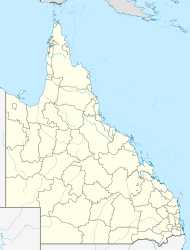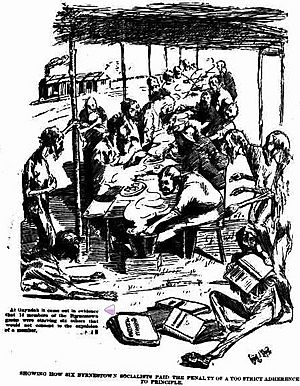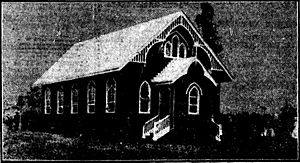Byrnestown facts for kids
Quick facts for kids ByrnestownQueensland |
|||||||||||||||
|---|---|---|---|---|---|---|---|---|---|---|---|---|---|---|---|
| Population | 27 (2021 census) | ||||||||||||||
| • Density | 0.672/km2 (1.74/sq mi) | ||||||||||||||
| Postcode(s) | 4625 | ||||||||||||||
| Area | 40.2 km2 (15.5 sq mi) | ||||||||||||||
| Time zone | AEST (UTC+10:00) | ||||||||||||||
| Location |
|
||||||||||||||
| LGA(s) | North Burnett Region | ||||||||||||||
| State electorate(s) | Callide | ||||||||||||||
| Federal Division(s) | Flynn | ||||||||||||||
|
|||||||||||||||
Byrnestown is a small rural area in Queensland, Australia. It is located in the North Burnett Region. This place is special because it was one of the first "communes" in Queensland. A commune is a community where people live and work together, sharing everything. In 2021, only 27 people lived in Byrnestown.
Contents
History
A New Idea: Communes in Queensland
Back in 1893, a man named William Lane had an idea about communities where everyone worked together and shared resources. The Queensland Government liked this idea. They passed a law called the Queensland Co-operative Communities Land Settlement Act. This law allowed groups of 30 or more men and their families to start a commune.
Many groups formed to create these communes. One group called themselves Byrnestown. They named it after Thomas Joseph Byrnes, who was the Queensland Attorney-General at the time. He later became the Premier of Queensland.
Starting the Byrnestown Commune
In January 1893, the Byrnestown group found suitable land in the Burnett area. It had water from Wetherton Creek and was near a future railway line to Gayndah. So, the Byrnestown commune was officially registered on 24 February 1894. It had 34 members and received about 4,600 acres of land for eight years.
Other groups also started communes nearby. The Resolute group settled just east of Byrnestown. Another group, Bon Accord, also took land in the Burnett area.
Life in the Commune
The first Byrnestown settlers arrived in March 1894. The government gave all communes some money to start. By June 1894, Byrnestown needed and received more financial help.
By October 1894, there were 169 people in the Byrnestown commune. This included 34 men, 28 wives, and 107 children. They built many bark houses and farm buildings. They also started working on a school. However, they had not cleared or planted much land yet.
Challenges and Changes
The Byrnestown commune did not last. By November 1894, there were rumors that some members were working outside the commune. They were supposed to share their wages with the commune, but they weren't. The group denied these claims.
The next month, some members asked the government for money. They said the commune's leaders were not giving them enough food. In February 1895, it was reported that 6 men had left the group. Another 9 refused to work. The group's secretary thought these problems were due to differences in nationality and religion.
An inspection in April 1895 showed little progress in farming the land. This was likely because many men were working outside the commune. By July 1895, members were even taking legal action against the leaders for not providing food.
Most communes in Queensland were struggling. In August 1895, a report said that most were "in a state of collapse." They were not able to support themselves financially.
The School and the End of the Commune
One good thing that happened was the opening of the Byrnestown Provisional School on 4 September 1895. However, the Byrnestown commune soon complained. Children from the nearby Resolute commune were attending their school without helping to pay for it.
In October 1895, the Byrnestown leaders made rules to punish members who criticized the commune. In December 1895, the Queensland Government passed a new law. This law allowed communes to be broken up and their land divided among the members.
The Byrnestown members quickly asked the government to divide their land. In April 1896, about 2,560 acres of the Byrnestown land were divided among 16 members. This brought the commune to an end. Those who took their own land generally did well. Less than two years later, they were described as "doing pretty well." This suggests that dividing the land helped the community by removing those who were not suited for farming or working together.
Later Development
By 1903, over 1,000 acres were being farmed in Byrnestown. They mostly grew maize, potatoes, and animal feed. The biggest challenge was being far from the railway.
The Byrnestown Provisional School was first in a simple bark hut. Later, it got a better building. It became a state school in 1909. A second school, Byrnestown Central State School, opened in 1913. The first school was then called Old Byrnestown School. The old school closed in 1931. Its buildings were moved to Wilson Valley in 1932. In 1938, Byrnestown Central State School was renamed Byrnestown State School. It closed on 31 December 1970.
Byrnestown also had post offices. One opened by November 1903 and closed in 1911. Another, Byrnestown Railway Station Post Office, opened by June 1910 and closed in 1974.
The Church in Byrnestown
In August 1913, local residents wanted to build a Roman Catholic church. They had a hall used for church services and fun activities. Later, a new concert hall was built, so their old hall was only used for church services.
Peter McSween senior donated an acre of land for the church. The residents decided to move the old hall to this land. On 25 July 1914, Archbishop James Duhig opened St Peter's Catholic Church. About 250 people attended. The church was made of wood and was about 40 by 20 feet. It had a sacristy, vestry, and a nice porch. A local builder named Harry Head designed and built it.
On 1 December 1923, a storm blew the church down. In August 1924, they decided to build a new church instead of repairing the old one. George William Jealous of Gayndah got the contract for over £1000. The new Catholic Church of the Sacred Heart opened in Byrnestown on 22 February 1925. Archbishop James Duhig opened it.
The church was damaged again in a cyclone in 1959. In 1969, the church was moved to Gayndah. It now serves as the church hall for St Joseph's Catholic Church there. To protect it from future cyclones, the roof was lowered, and the walls were made shorter.
A Runaway Train Carriage
In May 1931, something exciting happened. A railway carriage carrying the Queensland Premier Arthur Edward Moore and another politician, Robert Boyd, became detached. This happened during shunting (moving carriages around) at the Gooroolba junction. The carriage rolled away, gaining speed down a steep slope. It sped dangerously through Byrnestown railway station. It finally stopped five miles later on flat ground near the Wetheron railway station. Luckily, no one was hurt.
Demographics
In 2016, Byrnestown had a population of 34 people. In 2021, Byrnestown had a population of 27 people.
Heritage Listing
The Byrnestown Commune and its Cemetery are listed on the North Burnett Regional Council's local heritage register. This means they are important historical sites.




